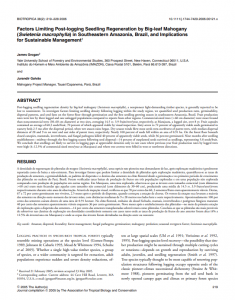Grogan, J. & Galvão, J. 2006. Factors limiting post-logging seedling regeneration by big-leaf mahogany (Swietenia macrophylla) in southeastern Amazônia, Brazil, and implications for sustainable management. Biotropica 38 (2): 219-22

Resume
Post-logging seedling regeneration density by big-leaf mahogany ( Swietenia macrophylla ), a nonpioneer light-demanding timber species, is generally reported to be low to nonexistent. To investigate factors limiting seedling density following logging within the study region, we quantified seed production rates, germinability, dispersal patterns, and seed fates on the forest floor through germination and the first seedling growing season in southeastern Amazonia, Brazil. Fruit production rates were low by three logged and one unlogged populations compared to reports from other regions. Commercial-sized trees (>60 cm diameter) were more fecund than noncommercial trees (30–60 cm diameter) at two sites, averaging 14.5 vs. 3.9 fruits/tree/year, respectively, at Marajoara, a logged site, over 8 yr. Fruit capsules contained an average of 60.3 seeds/fruit, 70 percent of which appeared viable by visual inspection. Sixty-seven to 72 percent of apparently viable seeds germinated in nursery beds 2.5 mo after the dispersal period, when wet season rains began. Dry season winds blew most seeds west-northwest of parent trees, with median dispersal distances of 28 and 9 m on west and east sides of parent trees, respectively. Nearly 100 percent of seeds fell within an area of 0.91 ha. On the forest floor beneath closed canopies, mammals, invertebrates, and fungal pathogens killed 40 percent of apparently viable seeds, while 36 percent germinated. Nine months after seedling establishment—midway through the first logging season following seed dispersal—14 percent of outplanted seeds survived as seedlings, representing 5.8 seeds/fruit. We conclude that seedlings are likely to survive in logging gaps at appreciable densities only in rare cases where previous year fruit production rates by logged trees were high (4–12.5% of commercial-sized trees/year at Marajoara) and where tree crowns were felled in west or northwest directions.

